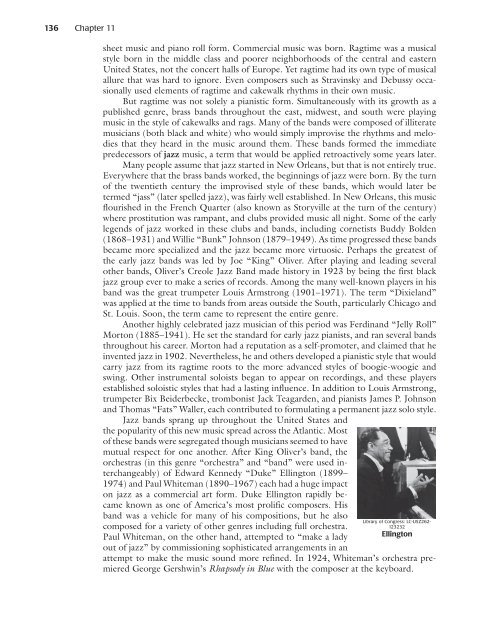Composer Profile - Activefolio
Composer Profile - Activefolio
Composer Profile - Activefolio
Create successful ePaper yourself
Turn your PDF publications into a flip-book with our unique Google optimized e-Paper software.
136 Chapter 11<br />
sheet music and piano roll form. Commercial music was born. Ragtime was a musical<br />
style born in the middle class and poorer neighborhoods of the central and eastern<br />
United States, not the concert halls of Europe. Yet ragtime had its own type of musical<br />
allure that was hard to ignore. Even composers such as Stravinsky and Debussy occasionally<br />
used elements of ragtime and cakewalk rhythms in their own music.<br />
But ragtime was not solely a pianistic form. Simultaneously with its growth as a<br />
published genre, brass bands throughout the east, midwest, and south were playing<br />
music in the style of cakewalks and rags. Many of the bands were composed of illiterate<br />
musicians (both black and white) who would simply improvise the rhythms and melodies<br />
that they heard in the music around them. These bands formed the immediate<br />
predecessors of jazz music, a term that would be applied retroactively some years later.<br />
Many people assume that jazz started in New Orleans, but that is not entirely true.<br />
Everywhere that the brass bands worked, the beginnings of jazz were born. By the turn<br />
of the twentieth century the improvised style of these bands, which would later be<br />
termed “jass” (later spelled jazz), was fairly well established. In New Orleans, this music<br />
flourished in the French Quarter (also known as Storyville at the turn of the century)<br />
where prostitution was rampant, and clubs provided music all night. Some of the early<br />
legends of jazz worked in these clubs and bands, including cornetists Buddy Bolden<br />
(1868–1931) and Willie “Bunk” Johnson (1879–1949). As time progressed these bands<br />
became more specialized and the jazz became more virtuosic. Perhaps the greatest of<br />
the early jazz bands was led by Joe “King” Oliver. After playing and leading several<br />
other bands, Oliver’s Creole Jazz Band made history in 1923 by being the first black<br />
jazz group ever to make a series of records. Among the many well-known players in his<br />
band was the great trumpeter Louis Armstrong (1901–1971). The term “Dixieland”<br />
was applied at the time to bands from areas outside the South, particularly Chicago and<br />
St. Louis. Soon, the term came to represent the entire genre.<br />
Another highly celebrated jazz musician of this period was Ferdinand “Jelly Roll”<br />
Morton (1885–1941). He set the standard for early jazz pianists, and ran several bands<br />
throughout his career. Morton had a reputation as a self-promoter, and claimed that he<br />
invented jazz in 1902. Nevertheless, he and others developed a pianistic style that would<br />
carry jazz from its ragtime roots to the more advanced styles of boogie-woogie and<br />
swing. Other instrumental soloists began to appear on recordings, and these players<br />
established soloistic styles that had a lasting influence. In addition to Louis Armstrong,<br />
trumpeter Bix Beiderbecke, trombonist Jack Teagarden, and pianists James P. Johnson<br />
and Thomas “Fats” Waller, each contributed to formulating a permanent jazz solo style.<br />
Jazz bands sprang up throughout the United States and<br />
the popularity of this new music spread across the Atlantic. Most<br />
of these bands were segregated though musicians seemed to have<br />
mutual respect for one another. After King Oliver’s band, the<br />
orchestras (in this genre “orchestra” and “band” were used interchangeably)<br />
of Edward Kennedy “Duke” Ellington (1899–<br />
1974) and Paul Whiteman (1890–1967) each had a huge impact<br />
on jazz as a commercial art form. Duke Ellington rapidly became<br />
known as one of America’s most prolific composers. His<br />
band was a vehicle for many of his compositions, but he also<br />
composed for a variety of other genres including full orchestra.<br />
Paul Whiteman, on the other hand, attempted to “make a lady<br />
out of jazz” by commissioning sophisticated arrangements in an<br />
Library of Congress: LC-USZ262-<br />
123232<br />
Ellington<br />
attempt to make the music sound more refined. In 1924, Whiteman’s orchestra premiered<br />
George Gershwin’s Rhapsody in Blue with the composer at the keyboard.



